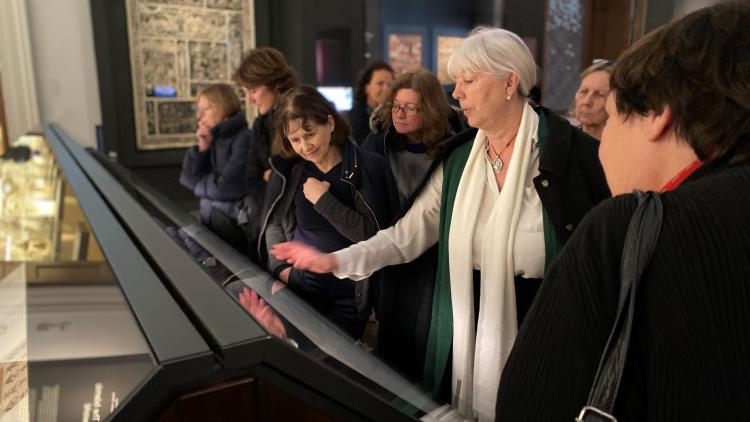BA Japanese



Key information
- Duration
- 4 years
- Start of programme
- September
- Attendance mode
- Full-time
- Location
- On Campus
- Fees
-
Home: £9,535
International: £23,780 - Course code
- T210
- Entry requirements
-
ABB
Contextual: BBB
-
Austria: Reifeprufungszeugnis / Maturazeugnis: four subjects at 1, 2, 2, 2
A Level equivalent: ABB
Contextualised offer: BBB -
Belgium: Diploma van Secundair Onderwijs: 75% (7.5/10, 15/20) overall
A Level equivalent: ABB
Contextualised offer: BBBInformation for prospective students from Belgium
-
Bulgaria: Diploma za Zavarsheno Sredno Obrazovanie: 5.3 and 5.0 in two State Maturity Exams
A Level equivalent: ABB
Contextualised offer: BBB -
Canada: High School Diploma: 80% with 5 acceptable Grade 12 subjects (most territories).
British Columbia: AABBB in Grade 12 courses.A Level equivalent: ABB
Contextualised offer: BBBInformation for prospective students from Canada
-
China: Senior Secondary Graduation Certificate + Gaokao: 78% overall in Gaokao PLUS 85% overall in Senior Secondary School Graduation Certificate (year 11 and 12)
A Level equivalent: ABB
Contextualised offer: BBBInformation for prospective students from China
-
Croatia: Matura Certificate: 4.5 overall with 5 in 1 Higher level subject
A Level equivalent: ABB
Contextualised offer: BBB -
Cyprus: Apolytirion with 2 A-Levels: Apolytirion 18/20 + A-level grades BB
A Level equivalent: ABB
Contextualised offer: BBB -
Czech Republic: Matura Certificate: 1, 2, 2, 2
A Level equivalent: ABB
Contextualised offer: BBB -
Denmark: Studentereksamen; Hojere Forberedelseseksamen; Hojere Handelseksamen; Hojere Teknisk Eksamen: 7 plus 10, 7, 7 in three Level A subjects
A Level equivalent: ABB
Contextualised offer: BBBInformation for prospective students from Denmark
-
Estonia: Gümnaasiumi lõputunnistus with the Riigieksamitunnistus: 4.0 with 85%, 80%, and 80% in 3 state exams
A Level equivalent: ABB
Contextualised offer: BBB -
Finland: Ylioppilastukint / Studentexamen: four subjects at 6, 5, 5, 5
A Level equivalent: ABB
Contextualised offer: BBB -
France: French Baccalaureat or Option Internationale du Baccalauréat (OIB): 13/20
A Level equivalent: ABB
Contextualised offer: BBBInformation for prospective students from France
-
Germany: Abitur: 1.8
A Level equivalent: ABB
Contextualised offer: BBBInformation for prospective students from Germany
-
Greece: Apolytirion of Geniko Lykeio with Pan Hellenic exams: 18/20
A Level equivalent: ABB
Contextualised offer: BBBInformation for prospective students from Greece
-
Hong Kong: Hong Kong Diploma of Secondary Education: 544 in two electives and one core (all other subjects grade 3)
A Level equivalent: ABB
Contextualised offer: BBBInformation for prospective students from Hong Kong
-
Hungary: Matura (Erettségi): 4.5 overall
A Level equivalent: ABB
Contextualised offer: BBB -
Iceland: Stúdentspróf: 7.5
A Level equivalent: ABB
Contextualised offer: BBB -
India: Standard XII: 75% (CBSE, CISCE, Tamil Nadu, Maharashtra & West Bengal boards), 80% (all other state boards)
A Level equivalent: ABB
Contextualised offer: BBBInformation for prospective students from India
-
Ireland: Irish Leaving Certificate: H1, H2, H2, H3, H3
A Level equivalent: ABB
Contextualised offer: BBB -
Israel: Bagrut: Overall grade of 7, 80% with 3 subjects at 5-unit level
A Level equivalent: ABB
Contextualised offer: BBBInformation for prospective students from Israel
-
Italy: Diploma Consequito con L’Esame di Stato: 80% overall
A Level equivalent: ABB
Contextualised offer: BBBInformation for prospective students from Italy
-
Latvia: Certificate of General Secondary Education: 88% in four State subject exams
A Level equivalent: ABB
Contextualised offer: BBB -
Lithuania: Brandos Atestatas: 8.5/10 and 90%, 85%, 85% in three State Exam
A Level equivalent: ABB
Contextualised offer: BBBInformation for prospective students from Lithuania
-
Malta: Advanced Matriculation Certificate: AB (Advanced) + BBB (Intermediate)
A Level equivalent: ABB
Contextualised offer: BBB -
Netherlands: Voorbereidend Wetenschappelijk Onderwijs: 7.5 overall with 8, 8, 7, 7 in four subjects
A Level equivalent: ABB
Contextualised offer: BBB -
Norway: Vitnemål vidergaende opplaering: 4.3 overall
A Level equivalent: ABB
Contextualised offer: BBBInformation for prospective students from Norway
-
Poland: New Polish Matura: 75% in three Advanced Level subjects
A Level equivalent: ABB
Contextualised offer: BBBInformation for prospective students from Poland
-
Portugal: Diploma de Ensino Secundario: overall 17.5/20
A Level equivalent: ABB
Contextualised offer: BBB -
Romania: Diploma de Bacalaureat: 8.5 overall
A Level equivalent: ABB
Contextualised offer: BBBInformation for prospective students from Romania
-
Singapore: Polytechnic Diploma (Nanyang, Ngee Ann, Singapore, Temasek and Republic Polytechnic): GPA 3.3
A Level equivalent: ABB
Contextualised offer: BBBInformation for prospective students from Singapore
-
Slovakia: Maturitná skúška / Maturita / Vysvedčenie o maturitnej skúške: four subjects at 1, 2, 2, 2
A Level equivalent: ABB
Contextualised offer: BBB -
South Africa: National Senior Certificate: 77666
A Level equivalent: ABB
Contextualised offer: BBBInformation for prospective students from South Africa
-
Spain: Curso de Orientación Universitaria / Título de Bachillerato: 7.5
A Level equivalent: ABB
Contextualised offer: BBBInformation for prospective students from Spain
-
Sweden: Slutbetyg / Examensbevis från Gymnasieskolan: A in 1200 credits and no grades below D / 18 / mainly B overall (MVG/VG)
A Level equivalent: ABB
Contextualised offer: BBB -
Switzerland: Federal Maturity Certificate: 4.5
A Level equivalent: ABB
Contextualised offer: BBB -
Tanzania: Advanced Certificate of Secondary Education: ACSE with BBB in 3 principle subjects
A Level equivalent: ABB
Contextualised offer: BBB -
Trinidad and Tobago: CAPE: Six CAPE units with grade 2 (+two double-unit courses)
A Level equivalent: ABB
Contextualised offer: BBB -
Turkey: Lise Diplomasi: 78-83% (depending on high school)
A Level equivalent: ABB
Contextualised offer: BBB -
USA: High School Diploma plus ACT, SAT, or AP exams:
-
High School Diploma GPA 3.0 plus SAT 1280 or ACT 27 and 2 AP's at 4,4
or -
High School Diploma GPA of 3.2 plus 2 AP's at 4,4
or -
High School Diploma GPA 3.4 plus SAT 1300 or ACT 29
or -
2-year Associate degree GPA 3.1
A Level equivalent: ABB
Contextualised offer: BBB -
-
See undergraduate entry requirements and English language requirements for international and alternative entry requirements.
Course overview
The BA Japanese programme provides you with the highest level of competence in all aspects of the written and spoken language, as well as an introduction to both classical and modern Japanese culture.
From the study of contemporary Japanese society, film and popular culture to pre-modern literature and history, the BA Japanese is suitable for both absolute beginners as well as those with some prior knowledge of the Japanese language. If you already have prior knowledge of Japanese, you must sit a placement test in welcome week which will determine your entry level. Further information about these placement tests will be sent out to successful applicants before the start of the academic year.
Students will spend the third year of study in Japan furthering their language proficiency and understanding of Japanese society and culture.
Why study Japanese at SOAS?
- SOAS is ranked 13th in the UK for Modern Languages (QS World University Rankings 2025)
- We are ranked 7th in the UK for Asian Studies (Complete University Guide Subject League Tables 2026)
- We are ranked 4th in the UK for 'graduate prospects' (Complete University Guide Subject League Table 2026)
Structure
Students take 120 credits per year composed of core, compulsory and guided modules.
- Year 1: students will learn Japanese language intensely and take history/culture modules and 15 credits of academic writing.
- Year 2: students will take modules of Japanese language and history/culture.
- Year 3: students will spend the year abroad at one of the Japanese universities with which we have exchange partnership agreements. Please note that not all Japanese universities listed below are available every year and that some of them have entry requirements.
- Year 4: students will continue their study of Japanese language, write an Independent Study Project and study further modules on history/culture.
Important notice
The information on the website reflects the intended programme structure against the given academic session. The modules are indicative options of the content students can expect and are/have been previously taught as part of these programmes.
However, this information is published a long time in advance of enrolment and module content and availability is subject to change.
Year 1 - J200 entry pathway - Core
Year 1 - J100 entry pathway - Core
J100 entry take 60 credits of language
Year 1 - J100 entry pathway - Compulsory
Year 1 - J200 entry pathway - Compulsory
Year 1 - J100 entry pathway - Guided options List A
Take 30 credits from J100 List A
Year 1 - J200 entry pathway - Guided options List A
Take three modules from J200 List A
Year 2 - Core
If J200 was completed in Y1, please select Japanese 4.
Year 2 - Compulsory
Year 2 - Guided options Language
Available to all students and subject to student's language level, placement test and/or convenors' approval
Year 2 - Guided options - List B
Take a minimum of 2 modules and a maximum of 4 modules from List B
Year 4 - Compulsory
Year 4 - Guided Option - List D
15-60 credits from List D
Year 4 - Guided option - List C
Choose at least 15 credits from List C
Teaching and learning
Most modules are taught through a combination of lectures and tutorial delivered across the week. Lectures are led by an academic while tutorials are sessions in which students are expected to present reports and take a lead in discussions.
Depending on the size of the class, some intermediate and advanced level modules are less strictly divided between a formal lecture and a tutorial discussion, and instead, the topic is briefly introduced by the lecturer, followed by a seminar discussion. Advanced level modules, which are usually taught in one two-hour bloc, often take this format.
The assessment procedures involve coursework assignments, tests and unseen examinations. They provide students with opportunities to demonstrate their knowledge and understanding of the content and systems taught in lectures, tutorials and the literature.
Contact hours
All full-time undergraduate programmes consist of 120 credits per year, in modules of 60, 30 or 15 credits. They are taught over 10 or 20 weeks. The programme structure shows which modules are taught over one term or the full year. It also shows which modules are compulsory and which are optional.
As a rough guide, 1 credit equals approximately 10 hours of work. Most of this will be independent study. It will also include class time, which may include lectures, seminars and other classes. Some subjects, such as learning a language, have more class time than others.
Year abroad
All students spend their third year in Japan at one of the Japanese universities listed below, following successful completion of their second year. Students will study a combination of language and non-language modules, and must pass 75% of them in order to proceed to Year 4. Please note that not all universities will have places available every year, and that each university has a limited number of places. Students indicate preferences, but final allocation will be determined by the department.
Tokyo
- Hitotsubashi University
- International Christian University
- Keio University
- Meiji University
- Ochanomizu University (women only)
- Sophia University
- Tokyo University of Foreign Studies
- Waseda University
Nagoya
Kyoto
Osaka
Kobe
Fukuoka
Hokkaido
SOAS Library
SOAS Library is one of the world's most important academic libraries for the study of Africa, Asia and the Middle East, attracting scholars from all over the world. The Library houses over 1.2 million volumes, together with significant archival holdings, special collections and a growing network of electronic resources.
Pre-entry reading
- B. Frellesvig, A History of the Japanese Language (Cambridge University Press, 2011)
- K. Friday, Japan Emerging: Premodern History to 1850 (Westview Press, 2012)
- C. Gerteis and T.S. George, Japan Since 1945: From Postwar to Post-bubble (Bloomsbury, 2013)
- C. Goto-Jones, Modern Japan: A Very Short Introduction (Oxford University Press, 2009)
- J. Hendry, Understanding Japanese Society (Routledge, 2012)
- M.B. Jansen, The Making of Modern Japan (The Belknap Press of Harvard University Press, 2000)
- H. Shirane, T. Suzuki, and D. Lurie (eds.), The Cambridge History of Japanese Literature (Cambridge University Press, 2015)
- P. Varley, Japanese Culture (University of Hawai’i Press, 2000)
Fees and funding
Fees for 2026/27 entrants per academic year
| Programme | Full-time | |
|---|---|---|
| Home students | Overseas students | |
| BA, BSc, LLB | £9,535 | £23,780 |
| BA/BSc Language year abroad | £1,425 | £11,770 |
See undergraduate fees for further details.
Employment
Graduates from the Department of East Asian Languages and Cultures develop competencies in intercultural awareness, analysis and communication. Demand for specialists with advanced proficiency in the languages of China, Japan and Korea has significantly increased in recent years, and graduates with these skills are highly sought after by employers.
Recent graduates have been hired by organisations including:
- Accenture
- Amazon
- Bloomberg LP
- Department for Work and Pensions
- European Alliance for Human Rights in North Korea
- European Commission
- ITN
- Japanese Government
- Korea Trade Centre (KOTRA)
- KPMG
- Mizuho Bank
- Nagahama Board of Education
- Nanjing Museum
- Pinsent Masons LLP
- PwC
- Seoul Metropolitan Government
- Shelterbox
- UNDP
Find out about our Careers Service.












